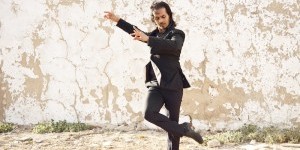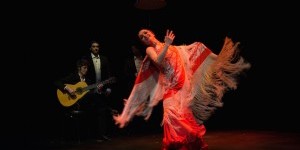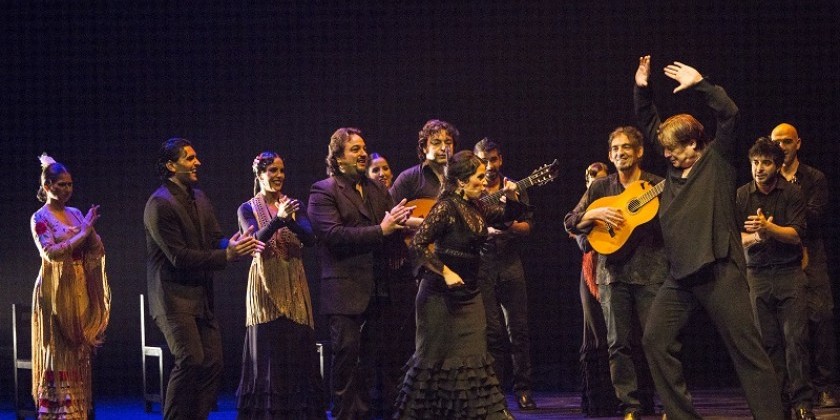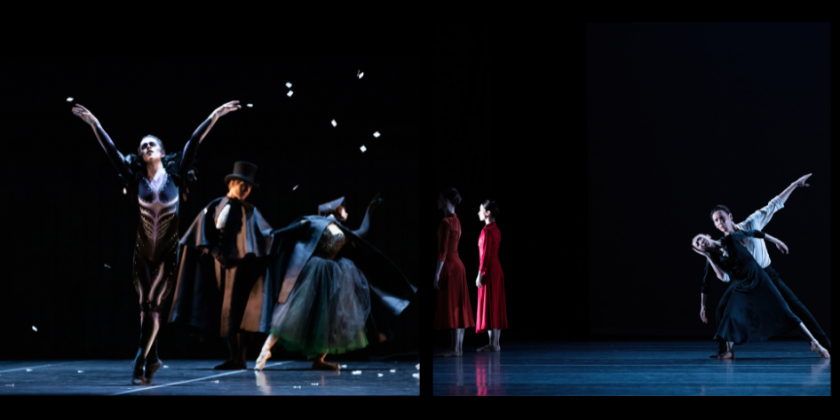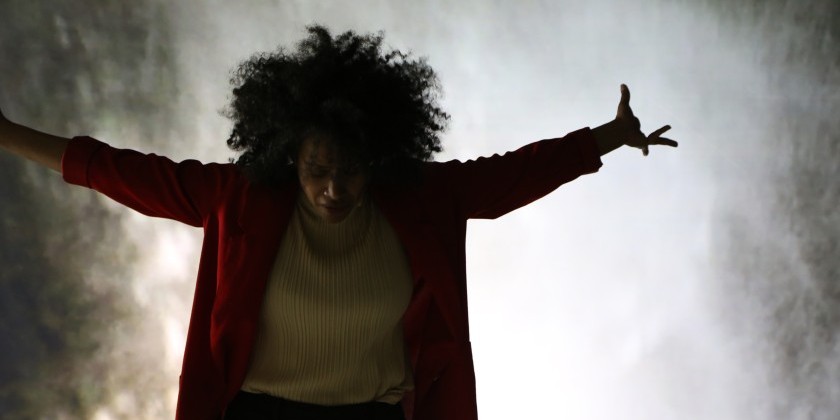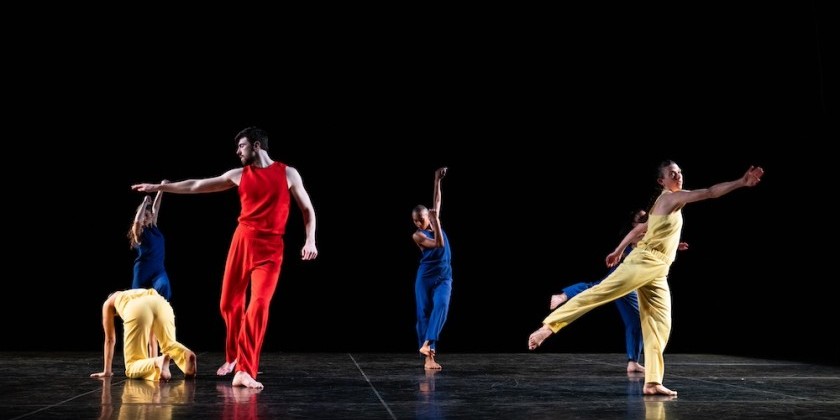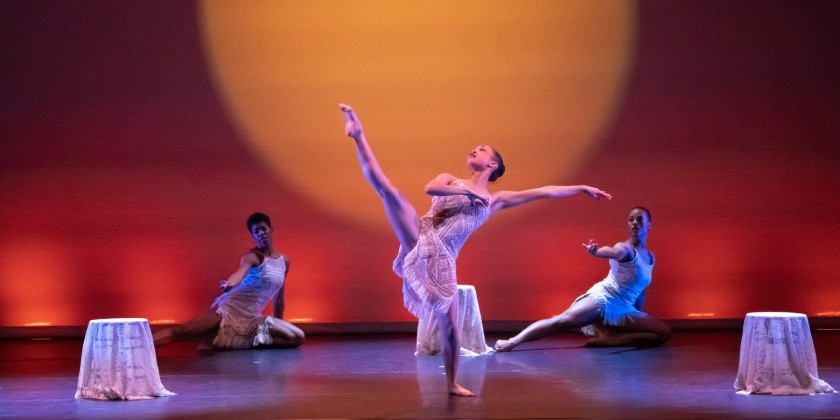IMPRESSIONS: New York Flamenco Festival with National Ballet of Spain, Olga Pericet, and Gala Flamenca
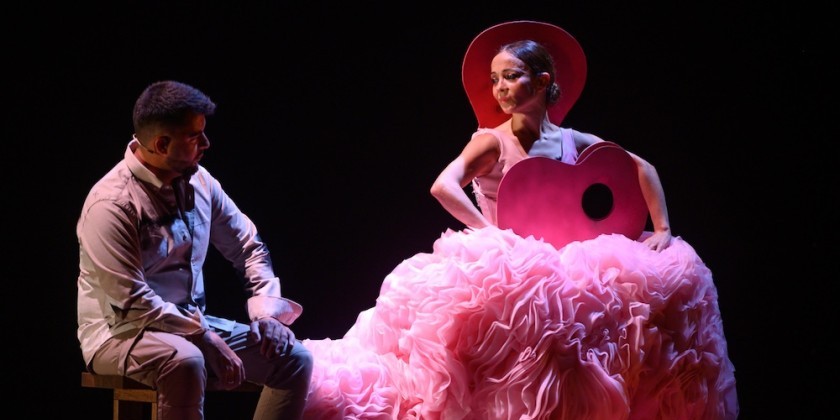
NEW YORK FLAMENCO FESTIVAL
Artistic director and producer: Miguel Marín
National Ballet of Spain
Artistic director and choreographer: Rubén Olmo
Invocación bolera, Jauleña, Eterna Iberia
Music by Manuel Busto, Orquesta de la Comunidad de Madrid // Castanets, Maribel Gallardo // Percussion, Agustín Diassera // Lighting design by Ginés Caballero and Felipe Ramos, Nicolás Fischtel //Costume design by Pedro Moreno, Rosa García Andujar, Yaiza Pinillos
De lo Flamenco
Staging, Mariana Ovalle // Costume design by Mario Maya // Costume paintings by Juan Andrés Amaya // Lighting Design by Ginés Caballero and Felipe Ramos // Vocalists: Saray Muñoz, Noemí Humanes, Luisa Carmona, Gabriel de la Tomasa, Juan José Amador “El Perre” // Guitar: Víctor Márquez, Enrique Bermúdez, Jonathan Bermúdez // Percussion: Roberto Vozmediano // Music by Mario Maya, Diego Carrasco, Jesús Torres, Moraíto Chico, Los Del Río // Choreography by Mario Maya, Rafaela Carrasco, A. Rueda “Toná,” Manolo Marín, Isabel Bayón // Text: Salvador De Madariaga, Miguel Hernández, Federico García Lorca, Carlos Lencero, M. Balmaceda, Diego Carrasco // Musical adaptation, Jesús Torres // Choreography adaptation, Manuel Betanzos
Dancers: Diego Aguilar, Cristina Aguilera, Ana Almagro, Estela Alonso, Sara Arévalo, Pilar Arteseros, José Manuel Benítez, Juan Berlanga, Marina Bravo, Irene Correa, Manuel Del Río, Patricia Fernández, Axel Galán, Álvaro Gordillo, Albert Hernández, Yu-Hsien Hsueh, Antonio Jesús Jiménez, Matías López, Adrián Maqueda, Álvaro Marbán, María Martín, Víctor Martín, Débora Martínez, Eduardo Martínez, Alfredo Mérida, Sara Nieto, Javier Polonio, Pedro Ramírez, Noelia Ruiz, Inmaculada Salomón, Carlos Sánchez, Irene Tena, Sergio Valverde, Laura Vargas, Vanesa Vento, Sou Jung Youn
Olga Pericet
Performance: La Leona
Choreography by Olga Pericet // Music by José Manuel León and Alfredo Mesa //Staging by Carlota Ferrer //Costume design by Olga Pericet and Carlota Ferrer // Costume construction by Maribel Rodríguez and Nuria Dorado //Lighting design by Gloria Montesinos // Production manager, Miquel Santín // Guitars: José Manuel León and Alfredo Mesa // Bass: Juanfe Pérez // Percussion: Roberto Jaén // Vocalist: Israel Moro
Gala Flamenca
Choreography by Manuel Liñán, Alfonso Losa, Paula Comitre, and El Yiyo // Music by David Carpio, Antonio Campos, Sandra Carrasco, Francisco Vinuesa, and Javier Ibáñez // Staging by Manuel Liñán // Lighting design by Álvaro Estrada //Production manager: Eva Marcelo
A rockstar performance by dancer Olga Pericet crowned the latest New York Flamenco Festival with the extravagant imagery of her show, La Leona. Yet stars of all kinds shone at this annual celebration of Spanish dancing, as the festival returned in full-strength, March 8-17.
Mainstage events at New York City Center also included appearances by the National Ballet of Spain, and a Gala Flamenca staged by Manuel Liñán, who framed his own provocations in a spare, traditional setting.
The genius of flamenco is timeless; but contemporary artists continue to pursue novelties. Thus, putting aside the antique laces of Boccherini’s celebrated fandango, the National Ballet opens its program with Invocación bolera, a 2019 collaboration between choreographer Rubén Olmo and trendy, 37-year-old composer Juan Manuel Busto Algarín. The new music creates a glowering atmosphere that pairs uneasily with the lightness and ornamentation of the Escuela Bolera: dancing characterized by rounded arms, batterie, and sprightly leaps. Olmo handles the ensemble fluently, and the dancers are game, but this score seems too dramatic for a divertissement.
Vibrant personalities fill the ranks of the National Ballet, however, just waiting for a chance to emerge. In Jauleña, Inmaculada Salomón’s fiery temperament elevates a modern solo that otherwise feels aimlessly busy; and in Eterna Iberia, Albert Hernández energizes the Farruca, his hands raised to strike in a crisp silhouette. Castanets trilling with excitement, Débora Martínez trysts with Eduardo Martínez, and who knows what happens when his hat conceals their faces from our eyes?
The second half features colorful pageantry of the type one expects from a national dance company, and clever gimmicks like the piece in which five men perform while seated on stools. Though lunging and stamping, their legs seem curiously weightless turning the dancers into marionettes. Once again, soloists rivet our attention. In Romance del Emplazado, José Manuel Benítez stamps emphatically and twists with passion, intensely concentrated and attentive to the music in moments of stillness. Eduardo Martínez reveals his natural lyricism — the true gift of dance — in Quisiera Ser. Seizing the opportunity, young dancer Noelia Ruiz steps forward to give a blazing performance in the Taranto, imbuing every gesture with her authoritative personality and a sense of freedom.
Olga Pericet takes stardom to another level, however, in La Leona, an evening-length spectacle designed to showcase this extraordinary artist’s virtuosity and imagination. Though the title of the work refers to a historic guitar, La Leona also celebrates a woman’s sexuality, with Pericet dancing orgasmically through a series of fantastic, even phantasmagoric vignettes.
In the opening, Pericet arises from a heap on the floor, gradually revealing her figure. Bare-breasted and anonymous behind a painted mask, she drapes herself in silken deshabille. Her legs, in a streetwalker’s long, black stockings and boots, seem dipped in ink. Blindly sensual, this character wakes to a percussive rhythm, tossing her hair like a lion’s mane and rolling her hips. She has a mesmerizing, erotic power. Pericet is equally comfortable, however, in male attire, returning later with her hair slicked down, wearing a jacket and pants. Now she swaggers like a man, turns corners decisively, and fascinates us with slowly unfurling gestures and moments of rapt concentration. Though apparently casual, she turns and strikes like lightning. Tossing her head back, she remains ecstatic.
In a comic episode, Pericet hides inside a yellow raincoat which she puppets, lifting it to create a giant whose heels click jauntily in the air. She plays castanets, and her feet drill with frictionless speed. Her slightest movement has a liquid quality; and at her most intense, she seems utterly carefree. Encased in a cascading pink bata of voluminous proportions, Pericet becomes a living sculpture with guitar cut-outs hanging from her arms---flamenco meets the Bauhaus. Then, in case anyone thinks she needs props, she strips it all away and performs a classic number framed by two musicians, tossing, stamping, and abandoning herself to the rhythm, dressed only in a loose, pink shift. Director Carlota Ferrer gets credit for the stagecraft, while composers and guitarists José Manuel León and Alfredo Mesa supply an adventurous electronic environment. Vocalist Israel Moreno, percussionist Roberto Jaén, and bass player Juanfe Pérez add their talents to the devoted ensemble, which Pericet goads and inflames.
After this flamboyance, some restraint seems advisable; and the Gala Flamenca directed by Liñán, returns us to the terrain of cante jondo. Here the only scenery consists of a handful of chairs and an atmosphere of raw emotion. Sandra Carrasco’s voice cries out suddenly in the darkness, and though the mood may wax sentimental, the comings and goings of dancers, singers, and musicians during the course of this evening will remain simple and direct. The exquisite musical ensemble, built around Carrasco, also includes cantaores Antonio Campos and David Carpio, with silver-toned guitarrists Francisco Vinuesa and Javier Ibánez, and percussionist Kike Terrón. The gala introduces a pair of rising stars, the long-legged gypsy Miguel Fernández Ribas, known as El Yiyo, 28 years old; and Paula Comitre, 30, a seductive artist formed at the Centro Andaluz de Danza and in the company of Rafaela Carrasco. Alfonso Losa, an established figure in Madrid, is also featured; and, naturally, Liñán gives himself the final word, in a gender-bending Soleá.
After a number in which the dancers introduce themselves, everyone has a moment in the spotlight. El Yiyo is full of mischief in the Alegrías, switching direction unpredictably, baring his shoulder, and snapping his fingers to carry us over a break in the music. He ranges restlessly around the stage, then charges down the center. In an a cappella section, he gets down to business, his zapateado thundering and racing, or as gentle as a heartbeat. A brusque exit cues the audience to applaud, but only so he can return and, amid this demonstration, lift his arms and face soulfully to the light offering himself to God. El Yiyo is a ham, but there’s no denying the rascal’s charm.
The Guajira is often a sunny and coquettish number, so it comes as a surprise when singers Antonio Campos and David Carpio introduce it here with a Spanish exile’s lament for his native land. Partly concealed behind the singers, Comitre seems to absorb their grief, and when she emerges her dancing combines refinement with dark passion. Twisting and darting, insinuating herself into the rhythm, she is repeatedly overthrown in backbends with a fan held overhead. Comitre offers a masterclass in how to manipulate the bata de cola, gathering up its frothy train in an outburst of stamping, kicking it aside, and — best of all — making it rotate in hypnotic circles whose speed she controls miraculously. This solo is dynamite.
While the Guajira is typically a palo danced by women, the Farruca is usually assigned to men. Contemporary artists like to challenge these stereotypes, but the distinction between genders already begins to break down when one considers that the qualities of greatest value in dancing — musicality, for instance — are equally important to men and women. Watching Comitre spin her bata, and then seeing Alfonso Losa smoothly diminish the speed of a turn in the Farruca reveals an artistic goal held in common, and gives similar satisfaction to the viewer. Losa’s Farruca is otherwise a dance of stern, masculine lines and emotional restraint, its dynamics minutely controlled, with the dancer gracefully extending a phrase or erupting in fireworks.
Perhaps what we are supposed to see in the concluding Soleá is a blending of male and female traits, as Liñán returns to the stage to perform in a bata and mantilla expressing his queer identity. This finale also responds to Olga Pericet’s performance in trousers, earlier in the festival. Yet the bata is not merely a costume. It is also a technique, and it must be said that Liñán’s explosive handling of both the train and the shawl is too effortful to be entirely successful, especially after we have seen Comitre. Liñán has a compact figure fairly bursting with energy, which he does not seek to conserve or modulate. He rampages his way through the Soleá, as he does through everything; and in the long, black dress he suggests Bernarda Alba with a hangover. Perhaps, with the passing years, he will learn the secret of doing more with less.






